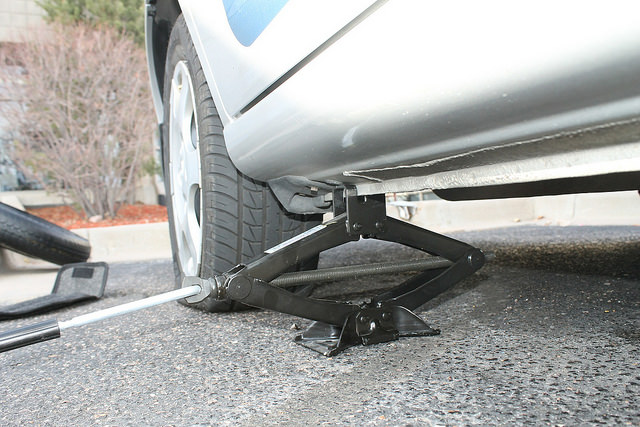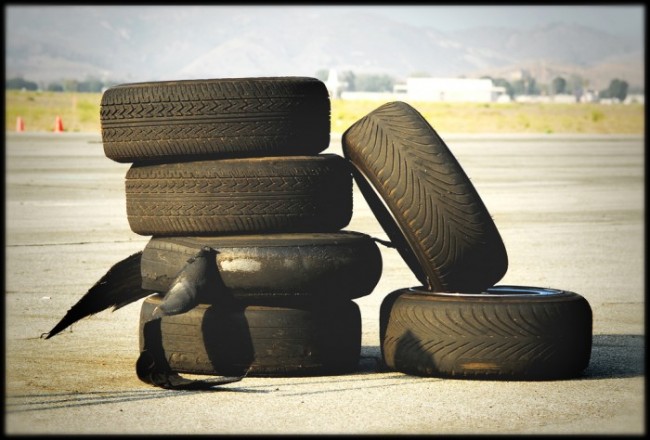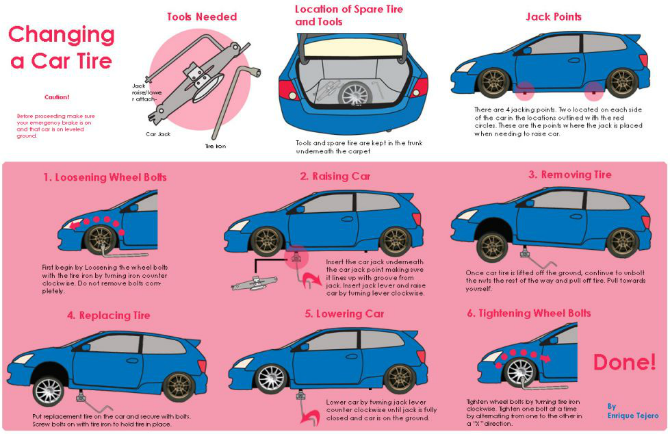Posted on 3/1/2022

Photo by Robert Laursoo on Unsplash In this month's blog, we share some tips on knowing if your car needs new tires! Changing your vehicle tires is more than just adding a new item to your vehicle. It ensures your safety while driving on the road, and you can have a smoother drive. When your tire treads are worn, your vehicle might not handle weather conditions to stop correctly. Keep in mind that having insufficient tread is considered illegal in many states, and if you are wondering how to know when it is time for new tires, below are some tips on how to figure it out. Penny trick: With president Lincoln's head pointing down, insert a penny into the grooves on your tire tread. If the tire tread hides any part of Lincoln's ... read more
Posted on 3/1/2016

Many car owners ask the question, “What do the numbers on my tires mean?” There is a lot of information printed on the side wall of every tire. This week, we’ll be examining an often overlooked set of tire number meanings. Your tire’s birth date or “tire birthday” is the approximate time that the tire was manufactured, and it's very important information to know when it comes to maintaining your vehicle. Read on to learn more about your tire’s numbers. Locating and Reading the Birth Date The tire birth date is not really a specific date, but rather the week and year the tire was manufactured. You can find it by locating a set of numbers that begins with “DOT." This string of letters and numbers will end with 3 or 4 numbers. For instance, your tire’s numbers might read DOT DA07 JN2S 4212. That last number, 4212, is the “birthdate”. The first half of the numbers, “42," indicates that the tire was made ... read more
Posted on 1/5/2016

Tires are one of the most important parts of your car when it comes to performance and safety. Thus, it’s crucial that your tires are always in working order and properly maintained. In particular, tire pressure is one of the most overlooked aspects of tire maintenance. Normal tires may lose up to 1 PSI per month under regular driving conditions. Therefore, you should check your tire pressure at least once a month to ensure that they’re inflated to the recommended PSI. For your information, let’s see why tire pressure matters so much for your car’s overall operation. Dangers of Driving with Under-Inflated Tires Driving on under-inflated tires can create a whole host of different problems for the tires and for overall performance. Lower tire pressure can cause the tire to bend and build up internal heat. Having the tires deflated by as little as 5 or 6 PSI below the recommended pressure (20% below) can result in problems such as: Reduced fuel economy Loss of s ... read more
Posted on 12/22/2015

Hydroplaning, or aquaplaning, occurs when a car’s tires start riding on a layer of standing water. In effect, the car loses all traction as the tires are spinning on the water rather than making direct contact with the ground. This causes a situation where the driver can lose control of the vehicle’s steering, acceleration, and braking. While hydroplaning can be a harrowing experience, there are many things you can do to prevent hydroplaning. Here are some tips for preventing and correcting hydroplaning. Recognize when you’re hydroplaning If your car starts to hydroplane, you can probably tell because of certain signs, including: Small turns of the steering wheel have no effect; micro-corrections don’t really do anything (since the car really can’t turn as there is no direct contact with the ground) The engine may get louder as RPM’s increase because the wheels are spinning faster. The steering wheel may begin to shake as the wheels are spinnin ... read more
Posted on 11/17/2015

Is your car drifting on the road? Is the steering not as responsive as it normally is? Does something just feel off when driving? If so, there might be a problem with the wheel alignment on your car that needs to be addressed by a certified professional technician. However, poor alignment is not the only potential cause of these problems—meaning it’s time to put on your Sherlock Holmes hat to determine if you actually need a wheel alignment. But don’t worry, it won’t be tough if you follow these 5 easy steps to identifying if your car needs a wheel alignment. Step 1: Eliminate Other Tire Issues Aside from poor alignment, tire issues are the other main culprits that cause symptoms like drifting and unresponsive steering. The first step in identifying if you have an alignment issue is to eliminate any other tire issues. Check the air pressure in all of your tires, because low air pressure could be causing similar problems. Although obvious, make sure your tires ar ... read more
Posted on 1/20/2015

If you haven't had one yet, you will eventually: the dreaded flat tire. You’re driving along, probably to work, and the car pulls to one side or loses momentum as the air escapes. Some cars have a tire pressure monitoring system that flashes, letting you know which wheel to check, or just turning on a light. So what now? Image: FlickrTurn on your hazards and pull off the road as quickly and safely as your are able. The shoulders on the highways were invented just for this kind of thing! (Make sure you don’t try to drive too far on a flat tire, you could do serious damage to your wheel or your drivetrain, turning a flat tire into a costly repair.) Safely exit the car and identify which tire is flat. Hopefully you already know where your spare tire is and know that it’s full of air, but if you don’t, check your owners manual for the loc ... read more
Posted on 11/14/2013

San Diego may not suffer the extreme temperature drops that other cities do, but that doesn’t mean we don’t have winter! In colder climates, drivers need to think about how to prepare their cars for winter: antifreeze, engine heaters, ice scrapers, snow tires...the list goes on. Here in Southern California, we only really have one major concern: tire pressure and condition. Image: Flickr As the temperatures drop in the winter months, the air in your tires gains density. That increased density means lower air pressure in your tires, leaving them under inflated. What does that mean? Underinflated tires can cause improper tire wear, reducing the lifespan of your tires. They can also reduce your fuel economy, as a tire with low pressure has increased resistance. Most importantly, an underinfla ... read more
Posted on 8/2/2012
So, everyone in the San Diego area knows how great helium is – you know, party balloons, squeaky voices. But a lot of people around still haven't heard about the benefits of nitrogen in your tires, and how it can help your tires. Here's some great advice from AutoNetTV, brought to you by Convoy Auto Repair. Nitrogen has actually been around for a long time in the commercial sector, but it's just starting to catch on for private vehicles in the 92111 zip code area. Why nitrogen in your tires? Air is air, right? Actually, it turns out there is a difference. The heart of the matter is maintaining proper tire inflation. When your tires are properly inflated, they last longer, handle better and more safely, and save you money at the gas pump. The problem is that tires filled with regular air can lose a pound and a half of air pressure every month. This just happens as the oxygen in the tire seeps out. So if you don't check your pressure for a month o ... read more
Posted on 5/31/2012

It's a scary thought to be driving in the middle of nowhere and have a tire that goes flat. But with the proper preparation and tools, this is a situation that can be easily handled. The tools you should keep in your trunk include a car jack, a wrench and a spare tire. Keeping a flashlight and tire blocks are useful to have as well. After you realize there is a tire issue, find a safe and flat place to pull your car over, set the parking brake, and turn on the hazard lights. Next, take all of the stored tools to the location of the flat tire. Once this is done, it is time to change your tire. How to Change a Tire <>Step 1: Loosen the wheel boltsYou may need to remove the hubcaps from the wheels beforehand. Then, use the wrench to loosen the bolts on the wheels by turning counter-clockwise. Do not completely remove the bolts at this point. Step 2: Raise the carThere are four main jacking points on a car. If you are unsure of the exact points, the owner ... read more
Posted on 3/29/2012
When winter approaches in San Diego, we break out the sweaters, coats, boots and mittens. We want to be ready for winter conditions. Your vehicle needs to be ready for winter as well. The last thing you want is to get stranded out in the cold. You need your vehicle to be safe and reliable. It's a good idea to get caught up on any neglected maintenance items anytime - but the stakes are higher in the winter. There are some specific things that we need to do in San Diego to have our vehicle ready for winter. The most obvious is having the antifreeze checked. If the antifreeze level is too low, it can't properly protect your engine, radiator and hoses from freezing. If your car does not seem to be making enough heat to keep you warm, your antifreeze level may be low or you could have a thermostat problem. Get it checked out. If you are due for a cooling system service, now is a perfect time to have it done. In the cold months around San Diego we always worry about being able to stop in t ... read more